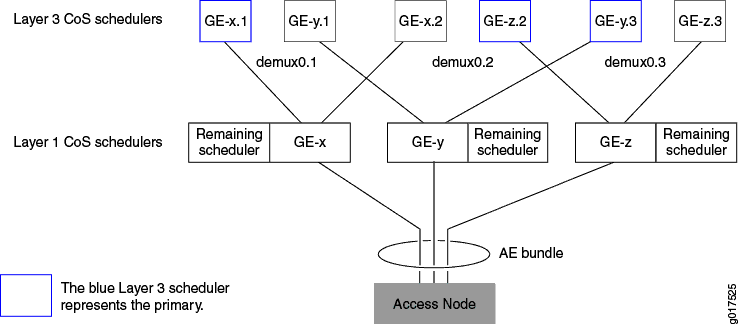Distribution of Demux Subscribers in an Aggregated Ethernet Interface
This topic describes the distribution options available for demux subscriber interfaces over aggregated Ethernet.
Distribution Models
By default, the system supports hash-based distribution for all subscriber interface types in an aggregated Ethernet bundle configured without link protection. In this model, traffic for a logical interface can be distributed over multiple links in the bundle. This model is desirable when there are many flows through the logical interface and you need to load balance those flows.
Note that if the distribution flows are not even, egress CoS scheduling can be inaccurate. In addition, scheduler resources are required on every link of the aggregated Ethernet interface. For example, if subscriber traffic is allocated 10 MB for a triple-play service over four links in a bundle, each of the links could receive 2.5 MB of traffic. High-density services such as video could be limited by the bandwidth on one of the links.
Targeted distribution enables you to target the egress traffic for an IP or VLAN demux subscriber on a single member link, using a single scheduler. To achieve load balancing over the member links, the system distributes the subscriber interfaces equally among the links. This enables the subscriber that is allocated 10 MB to be accurately scheduled as the traffic flows through.
Every child link in an aggregated Ethernet bundle consumes scheduler resources. That is, for example, a scheduler applied to a single physical interfaces consumes one scheduler resource. A scheduler applied to an aggregated Ethernet interface with five child links consumes five scheduler resources.
Sample Targeted Distribution Topology
Figure 1 displays a sample targeted distribution of subscriber traffic across links in an aggregated Ethernet interface. A primary and backup link is allocated for each subscriber.

For example, if link GE-x went down, subscriber 1 can begin forwarding over the backup, which is link Ge-y. When link GE-x comes back up, subscriber 1 switches back to its primary link, GE-x.
In the event that both GE-x and GE-y go down, subscriber 3 starts forwarding through its backup, GE-z. Subscriber 1 will have lost its primary and backup links, and will also begin forwarding out the GE-z link. A new level 3 scheduler is assigned for this subscriber on link GE-z. If there is a momentary lapse between the time that a new scheduler is allocated and forwarding switches to GE-z, the traffic will be forwarding through to the remaining scheduler. Subscriber 2 continues to forward through its primarily link, GE-z.
Redundancy and Redistribution Mechanisms
Two types of redundancy are available in the targeted distribution model: link redundancy and module redundancy.
By default, an aggregated Ethernet interface is enabled with link redundancy. Backup links for a subscriber are chosen based on the link with the least number of subscribers, which provides redundancy if a link fails.
The module redundancy option enables you to provide redundancy if a module or a link fails. Backup links for a subscriber are chosen on a different DPC or MPC from the primary link, based on the link with the least number of subscribers among the links on different modules. You can enable this for the aggregated Ethernet interface.
When links are removed, affected subscribers are redistributed among the active remaining backup links. When links are added to the system, no automatic redistribution occurs. New subscribers are assigned to the links with the fewest subscribers (which are typically the new links).
Considerations and Best Practices
Keep the following guidelines in mind when configuring targeted distribution for demux subscribers:
You can manage subscribers with both hash-based and targeted distribution models in the same network. For example, you can allocate subscribers with interface types such as PPPoE with hash-based distribution, and enable demux subscribers with targeted distribution.
We recommend that you configure module redundancy to protect against module failures. When module redundancy is enabled, you can ensure an even distribution of subscribers if you allocate no more than 50 percent of the links on a single DPC or MPC.
During normal network operations, the system maintains an even balance of subscribers among the links in a bundle, even as subscribers log in and out. However, if the distribution of a bundle becomes uneven (for example, when a link goes down and new subscribers are logging in), you can perform a manual rebalance of the bundle. In addition, you can configure periodic rebalancing of the bundle with a specific time interval.
When you anticipate that a link will be down for an extended time, and you want to ensure that backup links are provisioned for all subscribers, we recommend that you remove the failed link from the bundle. This forces the affected subscribers to redistribute to other links.
We recommend that you apply a remaining traffic-control profile to the logical interface to ensure that minimal scheduling parameters are applied to the remaining subscriber traffic. This provides scheduling for subscribers that do not have schedulers allocated because they have not been configured or they have been over-provisioned, or because of scheduler transitions on multiple link failures.
If you perform a cold restart on the router when it is forwarding active subscribers, the subscriber interfaces with targeted distribution are assigned to the first links that become available when the system is initializing so forwarding can begin. To rebalance the system following a cold restart, perform a manual rebalance of the bundle. In addition, we recommend that you configure Graceful Routing Engine switchover (GRES) on the router to enable nonstop forwarding during switchover, and avoid performing cold restarts.
To ensure appropriate and predictable targeted distribution, you must configure chassis network services to use
enhanced-ipmode.Unless specifically separated, multicast traffic egresses in parallel with unicast traffic, sharing the CoS hierarchy and aggregated Ethernet flow distribution.
